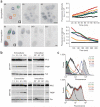Rapid control of protein level in the apicomplexan Toxoplasma gondii
- PMID: 17994029
- PMCID: PMC2601725
- DOI: 10.1038/nmeth1134
Rapid control of protein level in the apicomplexan Toxoplasma gondii
Erratum in
- Nat Methods. 2008 Jan;5(1):113
Abstract
Analysis of gene function in apicomplexan parasites is limited by the absence of reverse genetic tools that allow easy and rapid modulation of protein levels. The fusion of a ligand-controlled destabilization domain (ddFKBP) to a protein of interest enables rapid and reversible protein stabilization in T. gondii. This allows an efficient functional analysis of proteins that have a dual role during host cell invasion and/or intracellular growth of the parasite.
Figures


Comment in
-
Switching parasite proteins on and off.Nat Methods. 2007 Dec;4(12):999-1000. doi: 10.1038/nmeth1207-999. Nat Methods. 2007. PMID: 18049467 No abstract available.
Similar articles
-
Lysine acetyltransferase GCN5b interacts with AP2 factors and is required for Toxoplasma gondii proliferation.PLoS Pathog. 2014 Jan;10(1):e1003830. doi: 10.1371/journal.ppat.1003830. Epub 2014 Jan 2. PLoS Pathog. 2014. PMID: 24391497 Free PMC article.
-
An FKBP destabilization domain modulates protein levels in Plasmodium falciparum.Nat Methods. 2007 Dec;4(12):1007-9. doi: 10.1038/nmeth1132. Epub 2007 Nov 11. Nat Methods. 2007. PMID: 17994030
-
Switching parasite proteins on and off.Nat Methods. 2007 Dec;4(12):999-1000. doi: 10.1038/nmeth1207-999. Nat Methods. 2007. PMID: 18049467 No abstract available.
-
How does Toxoplama gondii invade host cells?J Vet Med Sci. 2018 Nov 23;80(11):1702-1706. doi: 10.1292/jvms.18-0344. Epub 2018 Oct 4. J Vet Med Sci. 2018. PMID: 30282883 Free PMC article. Review.
-
Histone mediated gene activation in Toxoplasma gondii.Mol Biochem Parasitol. 2006 Aug;148(2):109-16. doi: 10.1016/j.molbiopara.2006.03.010. Epub 2006 Apr 18. Mol Biochem Parasitol. 2006. PMID: 16644030 Review.
Cited by
-
A systematic screen to discover and analyze apicoplast proteins identifies a conserved and essential protein import factor.PLoS Pathog. 2011 Dec;7(12):e1002392. doi: 10.1371/journal.ppat.1002392. Epub 2011 Dec 1. PLoS Pathog. 2011. PMID: 22144892 Free PMC article.
-
Lysine acetyltransferase GCN5b interacts with AP2 factors and is required for Toxoplasma gondii proliferation.PLoS Pathog. 2014 Jan;10(1):e1003830. doi: 10.1371/journal.ppat.1003830. Epub 2014 Jan 2. PLoS Pathog. 2014. PMID: 24391497 Free PMC article.
-
An insertional trap for conditional gene expression in Toxoplasma gondii: identification of TAF250 as an essential gene.Mol Biochem Parasitol. 2011 Feb;175(2):133-43. doi: 10.1016/j.molbiopara.2010.10.007. Epub 2010 Oct 28. Mol Biochem Parasitol. 2011. PMID: 21035508 Free PMC article.
-
An overexpression screen of Toxoplasma gondii Rab-GTPases reveals distinct transport routes to the micronemes.PLoS Pathog. 2013 Mar;9(3):e1003213. doi: 10.1371/journal.ppat.1003213. Epub 2013 Mar 7. PLoS Pathog. 2013. PMID: 23505371 Free PMC article.
-
UAP56 is a conserved crucial component of a divergent mRNA export pathway in Toxoplasma gondii.Mol Microbiol. 2016 Nov;102(4):672-689. doi: 10.1111/mmi.13485. Epub 2016 Sep 14. Mol Microbiol. 2016. PMID: 27542978 Free PMC article.
References
Publication types
MeSH terms
Substances
Grants and funding
LinkOut - more resources
Full Text Sources
Other Literature Sources

